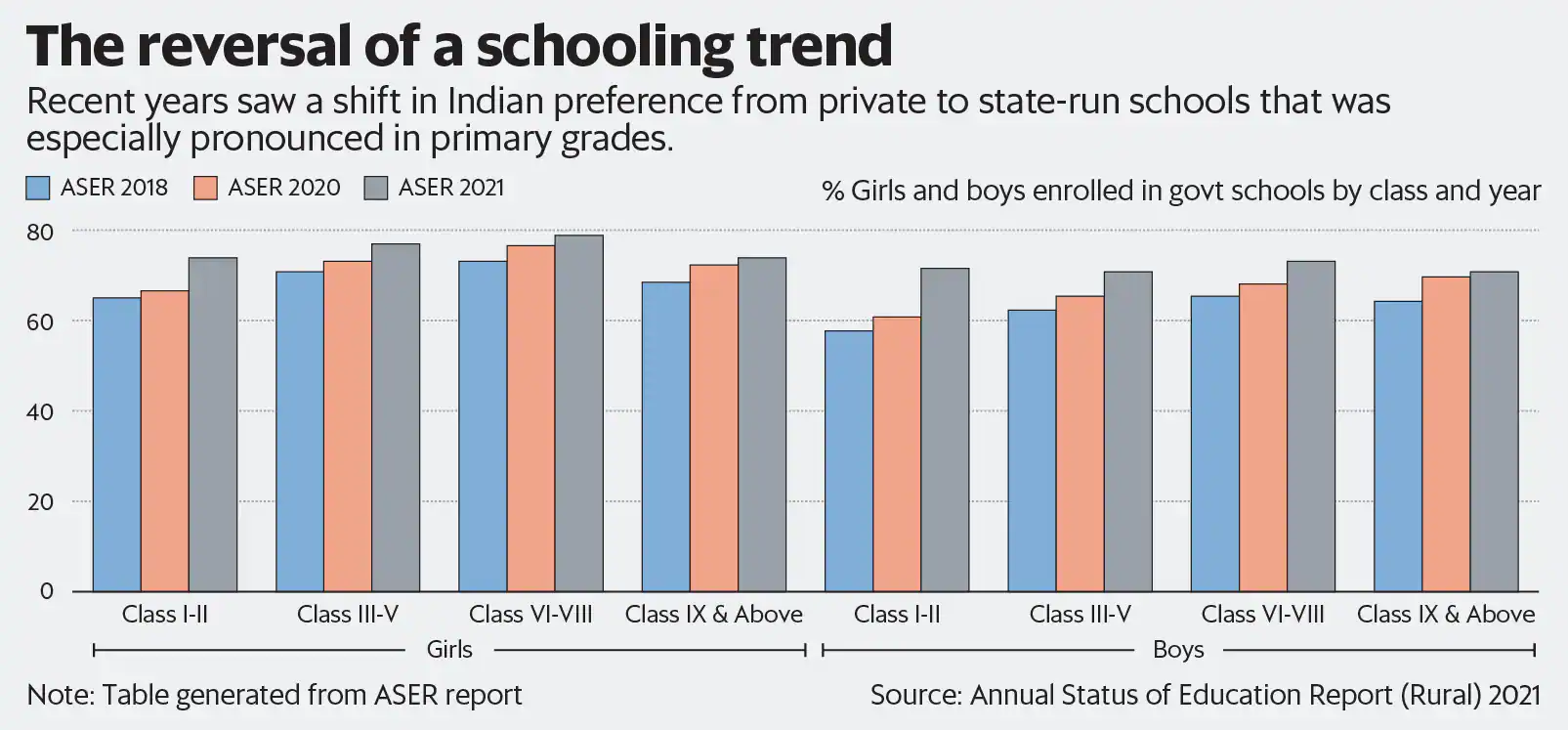Ahmedabad
(Head Office)Address : 506, 3rd EYE THREE (III), Opp. Induben Khakhrawala, Girish Cold Drink Cross Road, CG Road, Navrangpura, Ahmedabad, 380009.
Mobile : 8469231587 / 9586028957
Telephone : 079-40098991
E-mail: dics.upsc@gmail.com

Time to Revamp Schools as they Reopen after Pandemic Break
After remaining shut for about two years due to Covid-19 pandemic, schools have gradually started re-opening and welcoming children back. However, with almost a 2-year absence from school premises most of the students have spent time at home with either semi-structured or no educational activity.
This calls for urgent actions from schools for resuming structured educational activities along with assuring conducive classroom spaces which are sensitive to the prolonged anxiety, stress and isolation that students face. The question of school preparedness becomes even more pertinent as we see increasing enrollment in government schools throughout India.
Trends in Enrollment Scenario:
• The Annual Status of Education Report (ASER) Report 2021 for rural India notes that there has been a shift in enrolment from private to government schools between 2018 and 2021 across all grades and among both boys and girls. The increase is most striking among children enrolled in the lowest grades.
• Overall, a total of 17 states saw an increase in enrolment in government schools. Uttar Pradesh and Kerala topped the chart. The shift highlights a significant change as it reverses a decade-long trend where private school enrolment kept growing at the expense of government schools.
• Nagaland and Manipur although saw a decrease in enrolment levels in government schools over the period under review. However, it does not mean students have shifted to private schools, but it reflects large number of students who are currently not enrolled in these states.
• On average in 2021, the proportion of children aged 6-14 currently not enrolled in school has increased by 2.1 percentage points compared to the 2018 level, with states like Andhra Pradesh (7%), Manipur (15.5%), Nagaland (19.6%) and Telangana (11.8%) showing a high increment in their currently-not- enrolled levels compared to 2018.
Challenges observed:
• The ASER presented its findings on ‘Learning Levels’ for West Bengal, Chhattisgarh and Karnataka which showed that there is a learning crisis in these states and the situation might be the same in other states and UTs.
• For example, In West Bengal, there is a decline in the proportion of children enrolled in Class 1 in government schools who can read letters of the alphabet and read single-digit numbers.
• As per data for 2019-20 from the Unified District Information System for Education (UDISE), only 12% of all government schools had internet facilities and only 30% had computers.
• Pandemic disruptions drew attention to the challenges of teachers, who were offering educational and non-educational support to school students across India. Even before the outbreak, the educational landscape of India was mired in a range of challenges - recruitment and management of teachers, inadequacy of teacher training and a teacher shortage.
• Learning loss amongst children was observed massively as schools were the ones to remain shut for the longest period, online education was not affordable to most. When schools started to reopen, children were unable to catch up with their syllabus.
What can the government do and what is already being done?
• Starting this academic year, schools should identify the children who are lagging behind and run basic revision and bridge programmes for them to consolidate their skills of reading, writing, numeracy and comprehension. The NIPUN BHARAT initiative, is a reassuring step in that direction.
• The rising enrolment levels in the government schools offer a chance for the central as well as state governments to ensure the retention of students. It offers a clear indication of people’s expectations of the state’s role in providing education as a matter of right and not just another ‘service’.
• The need of the hour is to improve the perceptions of various stakeholders (especially parents and children) vis-à-vis state run-schooling systems in India.
• Priority must be given to lesser privileged students who did not have access to e-learning during the pandemic.

Address : 506, 3rd EYE THREE (III), Opp. Induben Khakhrawala, Girish Cold Drink Cross Road, CG Road, Navrangpura, Ahmedabad, 380009.
Mobile : 8469231587 / 9586028957
Telephone : 079-40098991
E-mail: dics.upsc@gmail.com
Address: A-306, The Landmark, Urjanagar-1, Opp. Spicy Street, Kudasan – Por Road, Kudasan, Gandhinagar – 382421
Mobile : 9723832444 / 9723932444
E-mail: dics.gnagar@gmail.com
Address: 2nd Floor, 9 Shivali Society, L&T Circle, opp. Ratri Bazar, Karelibaugh, Vadodara, 390018
Mobile : 9725692037 / 9725692054
E-mail: dics.vadodara@gmail.com
Address: 403, Raj Victoria, Opp. Pal Walkway, Near Galaxy Circle, Pal, Surat-394510
Mobile : 8401031583 / 8401031587
E-mail: dics.surat@gmail.com
Address: 303,305 K 158 Complex Above Magson, Sindhubhavan Road Ahmedabad-380059
Mobile : 9974751177 / 8469231587
E-mail: dicssbr@gmail.com
Address: 57/17, 2nd Floor, Old Rajinder Nagar Market, Bada Bazaar Marg, Delhi-60
Mobile : 9104830862 / 9104830865
E-mail: dics.newdelhi@gmail.com